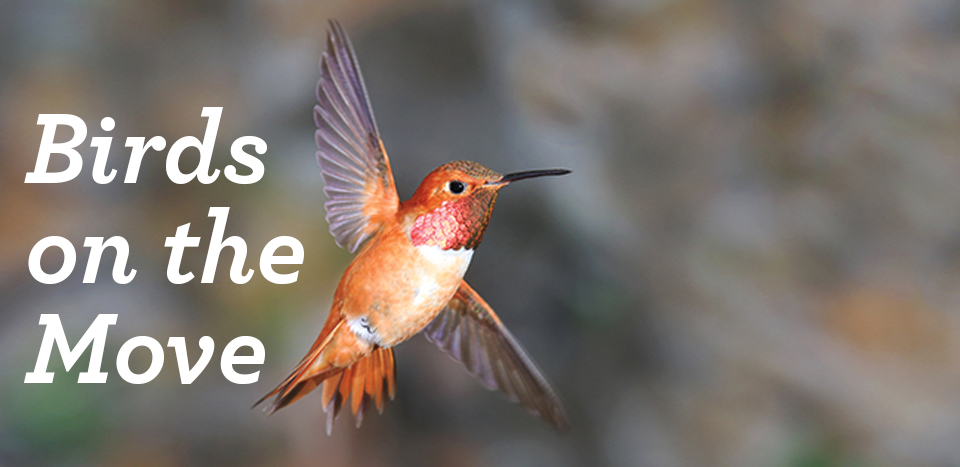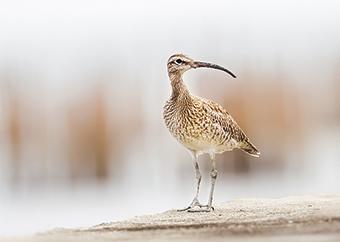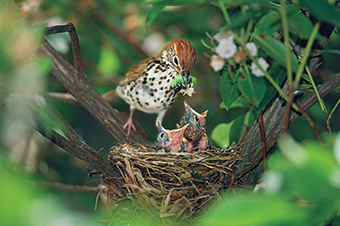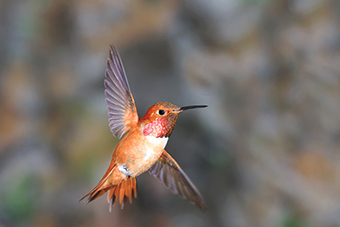
Audubon Adventures

Background for Teachers
Most of the approximately 700 avian species that breed in the United States and Canada spend much of the year migrating between breeding ranges and wintering ranges. Among these travelers are more than 350 neotropical migrants—birds that breed in Canada and the United States and spend winter in tropical parts of Central and South America and the Caribbean.

Time: Late spring.
Place: A tidal marsh near the coast of North Carolina.
A large bird probes in the mud with its downward-curving bill, searching out worms, crustaceans, and mollusks. This Whimbrel is stopping to feed as it makes its way from its winter home in the Caribbean to the Arctic tundra, where it will breed and raise its young with its lifelong mate.
On any day, birds are migrating somewhere, but spring and fall are the busiest seasons—a time when billions of birds wing their way through the skies, day and night. Birds that migrate do so because it’s proven to be an effective strategy for survival and reproduction.
Insect-eating land birds, for example, can’t depend on a steady supply of insects during a northern winter. Nor can a nectar-feeder, such as a hummingbird, rely on flowers. By migrating to tropical regions, however, they can tap into resident birds’ year-round supply of food.
Why, then, don’t migrants stay put in springtime? Because staying means competing for a limited supply of nest sites and food during the breeding season, when birds need a plentiful supply of protein-rich food to feed their young. By migrating farther north, however, birds can exploit a new crop of insects and nectar-laden flowers. In Arctic regions, for example, huge numbers of insects take advantage of warmth and long sunny days to fulfill their own breeding and feeding needs.
Thus, insect-eating birds benefit from an incredible seasonal abundance of food. Likewise, migratory raptors can prey on spring’s bounty of rodents, fruit- and nectar-feeding birds find fresh meals, and fish-eating seabirds and plant-eating waterfowl also benefit by traveling to where the getting is good.
Challenges and Threats
While the benefits of migration are substantial, migratory species pay a price for them. Migration is hazardous and exhausting. Of the more than 5 billion individual birds that migrate south for the winter, it’s estimated that about half (mostly young birds from the previous breeding season) do not make it back to their breeding range in spring. Some of these birds die due to natural causes: disease, predation, bad weather, storms that blow them off course. But human activity has added to the perils faced by migrants.

Time: Early summer.
Place: An eastern Tennessee forest.
A Wood Thrush lands on the edge of its nest, greeted by the gaping mouths of its hungry hatchlings. In the fall, they will all head south toward Central America. When they reach the coast of the Gulf of Mexico, they will fly across it nonstop.
Some birds are weakened or killed by pesticides. In the mid-1990s, for example, thousands of Swainson’s Hawks died on their Argentinean winter range, poisoned by a pesticide used to kill grasshoppers, the birds’ main prey; more than 20,000 hawks—5 percent of the world’s total population—perished. Brightly lit high-rise buildings are another major threat to migrating birds. In May 2017, nearly 400 migrating warblers were killed in a single night when they crashed into a high-rise building in Galveston, Texas.
The biggest threat to birds, however, is the loss and fragmentation of habitat in breeding and wintering ranges and along migratory routes. Coastal development, deforestation, oil production, ranching, and conversion of grasslands to farmlands (and wild areas and farmlands to paved developments) all take a toll on habitat, not only in breeding and wintering areas, but in the places they stop during migration to rest and feed. Increasingly, climate change is being examined as a threat factor. The population of the endangered Piping Plover is estimated to be about 8,000 individuals. Their breeding grounds along the Atlantic Coast face not only degradation and destruction because of human development, but because of rising seas associated with a warming climate.
Audubon’s 2014 report, Birds and Climate Change, found that more than half—314 species—of the 588 North American bird species studied are in trouble because of global warming. The changing climate is altering habitat and reducing birds’ ranges, putting them at risk. An example is the Pacific Brant, which appears to be changing its migratory habits as a result of warmer temperatures and more food on its winter range. About 30 percent of the Pacific Brant population now winters in Alaska instead of flying south to Mexico.
Acting to Identify and Reduce the Threats
Many efforts are underway to combat threats to migratory birds described above. Argentina, for example, restricted the use of the pesticide that killed Swainson’s Hawks in the 1990s, and banned it in 2000. The problem of bird collisions with windows was first recognized in Toronto, Canada, leading to the establishment of FLAP (“Fatal Light Awareness Program”). In the United States, a project called “Lights Out” has a similar mission: to reduce bird collisions with windows, especially in high-rise buildings. In cities all across the country, building owners and managers are turning off excess lighting at night during the months migrating birds are passing through. On the local level, birders, schools, and other community organizations work to protect local habitats.

Time: Early fall.
Place: The foothills of the Rocky Mountains.
A tiny Rufous Hummingbird dips its long bill into a nectar-filled flower. It is pausing here to refuel on its annual fall migratory journey of nearly 4,000 miles from Alaska to Mexico.
Given the global nature of the threats and the fact that birds are world travelers, cooperation across international borders is essential to identifying threats and protecting birds throughout their ranges. An example is Audubon’s partnership with the Virginia Tech Shorebird Program and the Bahamas National Trust to map the migratory journeys of banded Piping Plovers in order to identify breeding, stopover, and wintering grounds in the United States, the Bahamas, and the Caribbean. That’s the first step in monitoring and taking steps to protect essential habitat for the endangered plovers.
On local and global levels, the effects of climate change on migratory birds will continue to be studied. Cutting down on factory and automobile emissions, conserving energy whenever possible in homes and businesses, and other efforts to combat global warming will benefit not only migratory birds but all living things. The same is true for actions at all levels that conserve and protect habitat for birds, other wildlife, native plants, and human beings.
Photos: Frank Leung/iStock; Kajornyot Krunkitsatien/AdobeStock; Ashley Peters.




